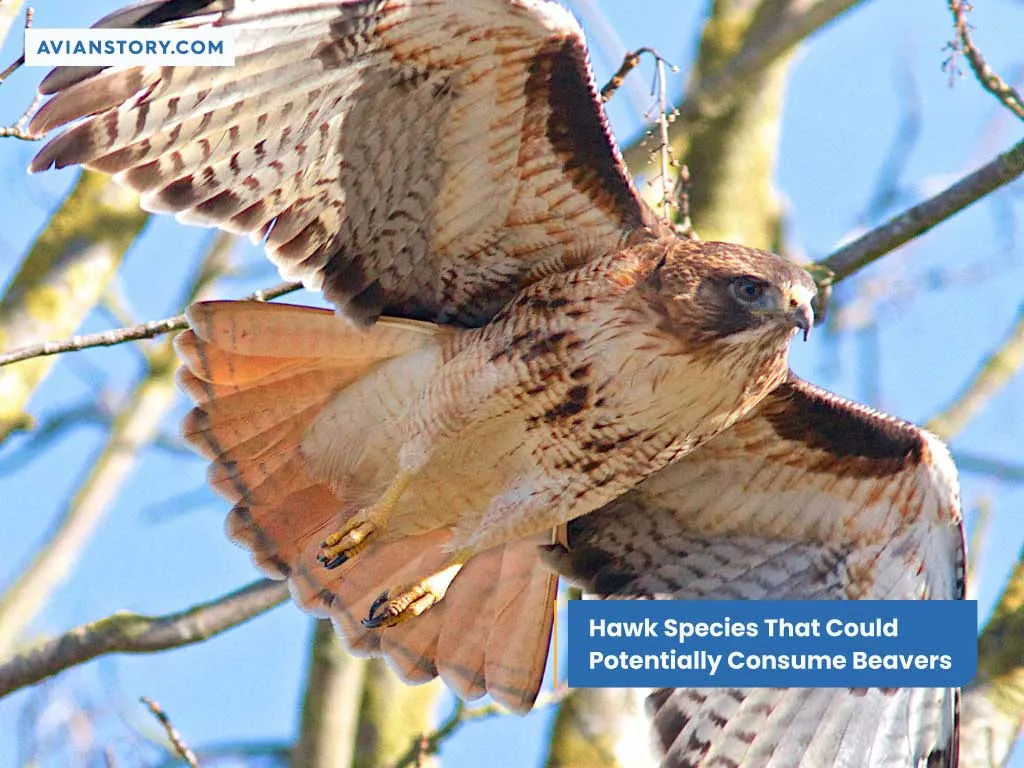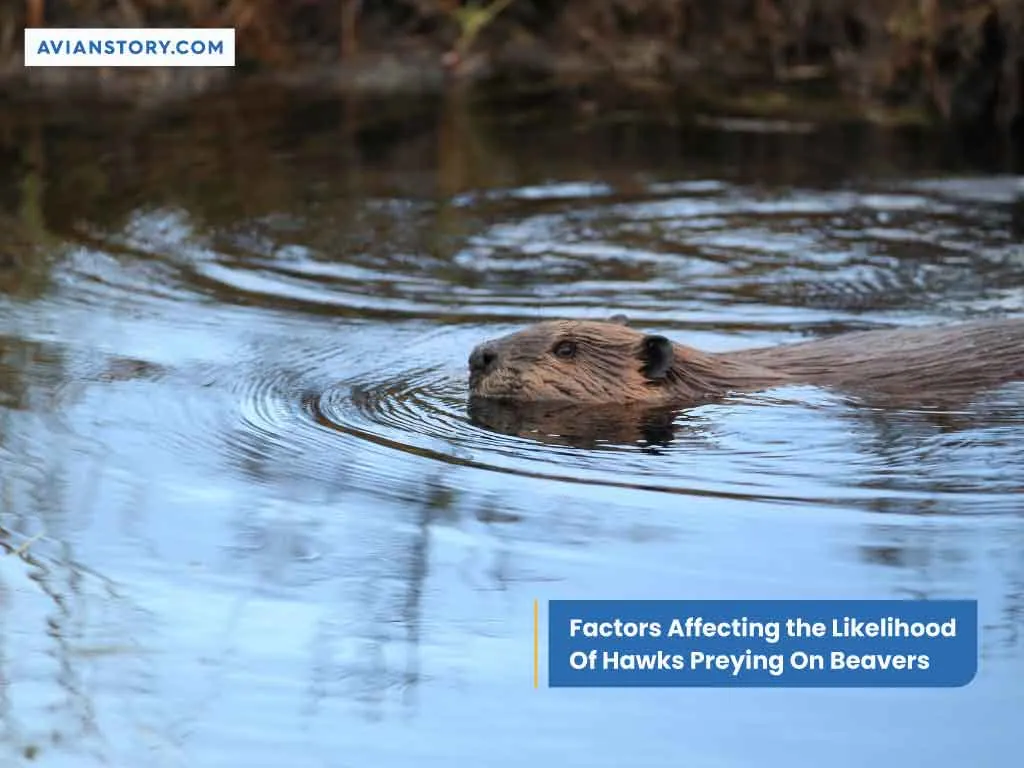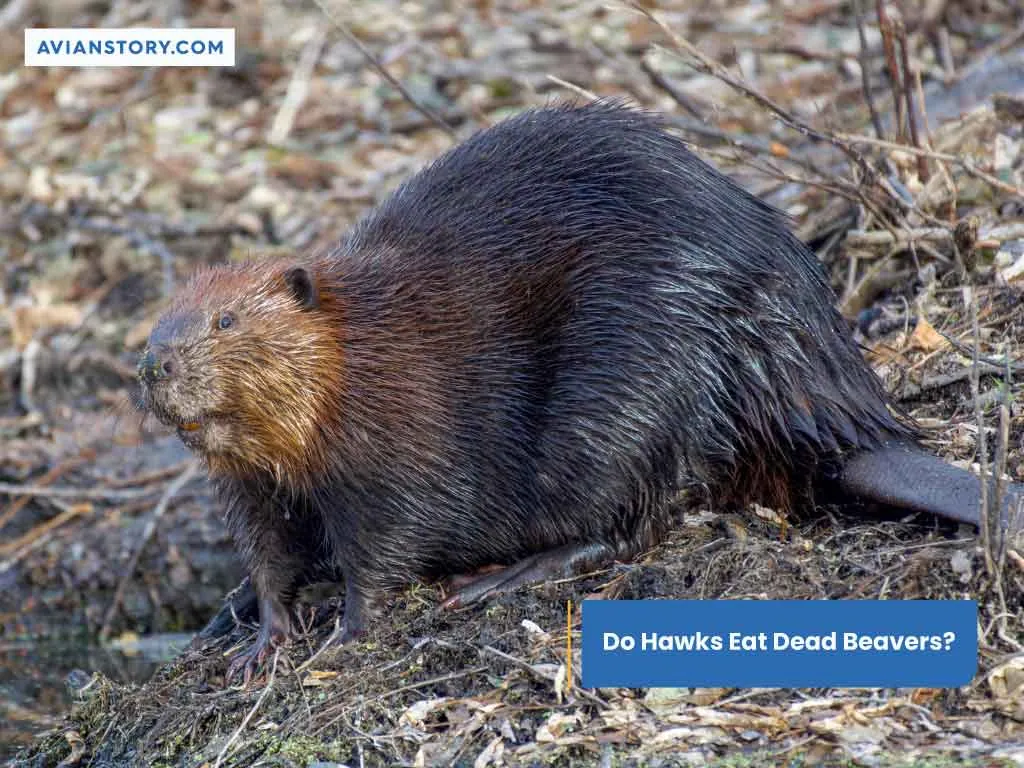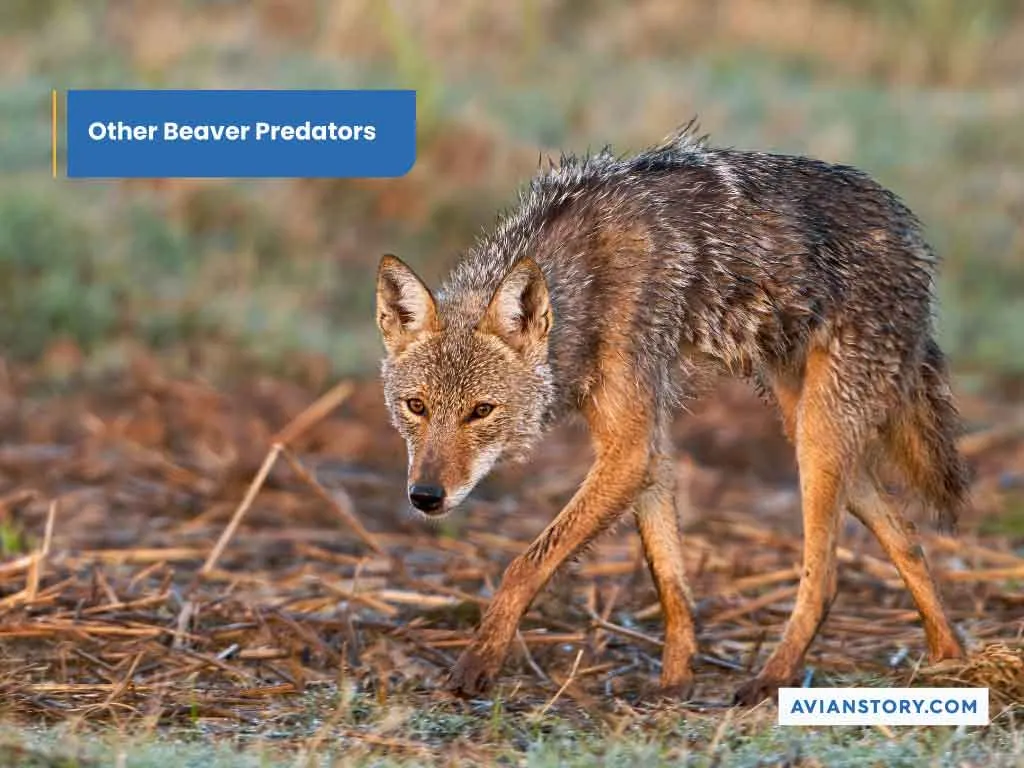Do Hawks Eat Beavers? Understanding the Predator-Prey Relationship
Consider the majestic sight of a hawk soaring high in the sky, its sharp eyes scanning the landscape below for its next meal. Now picture a beaver, a master builder of dams, gliding through the water effortlessly. Will the hawk prey on the beaver while it is searching for food? Let us dive into that!
The answer is not straightforward. While hawks are known to prey on small mammals, beavers are typically not on their menu. Beavers are too large for hawks to take down. However, some hawk species, e.g., the Goshawk and the Red-tailed hawk, have a taste for beavers.
This article will explore the predator-prey relationship between hawks and beavers and uncover the facts behind this curious question. We will also discuss factors affecting the likelihood of hawks preying on beavers and the human impact on hawk-beaver predation.
Hawk Species That Could Potentially Consume Beavers

Over 250 species of hawks worldwide exist, but only a few are large enough to consider preying on beavers. Before we dive into the hawk species that feed on beavers, let us answer the question, “What do hawks eat?”
Hawk diets vary depending on species and habitat, but common prey items include rodents, small mammals like rabbits and squirrels, birds, reptiles, and insects. But hawks being opportunistic hunters, some of them might still eat beavers. Here are some of the hawks that eat beavers.
- Red-Tailed Hawk: Red-tailed hawks are one of the largest hawk species in North America and are known for their impressive hunting skills. They inhabit various habitats, including forests, grasslands, and deserts.
These hawks are known to prey on larger animals such as squirrels, snakes, and rabbits. While beavers are not a regular part of their diet, red-tailed hawks may occasionally target beavers as prey, especially if they are hunting in areas where other prey is scarce.
- Cooper’s Hawks: Cooper’s Hawks are another species of hawk in North America known to prey on beavers. They are medium-sized species with a wingspan of up to 36 inches.
Cooper’s Hawks are known for their agility and speed, allowing them to catch fast-moving prey like flying birds. While they are not typically thought of as a beaver predator, they have been observed hunting beavers in some areas.
- Northern Goshawk: The Northern Goshawk is a large hawk species throughout the northern hemisphere, including North America, Europe, and Asia. This particular hawk is known for many beaver attacks and has been observed to like them.
Goshawks are mighty hunters who prey on other birds and small mammals like rabbits and squirrels. However, their range has decreased due to habitat loss, making it less likely for them to prey on beavers in certain areas.
- Ferruginous Hawks: Another hawk species that could potentially prey on beavers is the Ferruginous hawk. Ferruginous hawks are large, robust birds of prey that inhabit open grasslands and desert areas.
Given their size and hunting behavior, ferruginous hawks may occasionally target beavers as prey, especially if they are hunting in areas where beavers are abundant.
An Overview of North American Beavers (Castor canadensis)

Beavers are large, semi-aquatic rodents throughout North America, Europe, and Asia. They are known for their distinctive appearance, with flat tails and large, chisel-like teeth that they use to fell trees and build dams and lodges.
The North American Beaver, or Castor canadensis, is the largest species of beaver and is found throughout North America, from northern Mexico to Alaska. They are an essential part of the ecosystem, as their dams and lodges create habitats for various aquatic plants and animals.
North American beavers are well-adapted to their semi-aquatic lifestyle. They have webbed feet, waterproof fur, and can hold their breath for up to 15 minutes underwater.
An adult male beaver can grow up to 1.2 meters (4 feet) long and weigh between 18 and 32 kg (40 and 70 lbs). On the other hand, adult female beavers are slightly smaller, measuring up to 0.9-1.1 meters (3-3.5 feet) in length and weighing between 13-24 kg (30-50 lbs).
They primarily feed on the bark and leaves of trees and shrubs but will also eat aquatic plants, roots, small fish, and invertebrates.
Beaver Dams and Lodges
Beavers are known for their ability to build dams and lodges, which protect them from predators and stable living conditions. Dams are built by felling trees and using them to create a barrier across a stream or pond. This creates a deep pool behind the dam, which allows the beavers to swim freely and avoid predators.
Beaver lodges are also made from branches and logs and built on the water or the shore. They provide the beavers with a dry, safe place to rest and store food during the winter.
Behavior And Communication
Beavers are social animals and live in family groups called colonies. These colonies consist of a breeding pair and offspring from the previous two years. Beavers communicate with each other through a variety of vocalizations, including whines, grunts, and tail slap.
Tail slapping is an essential form of communication, as it is used to alert other beavers to potential dangers like predators or approaching humans. When a beaver slaps its tail on the water, it creates a loud noise that can be heard throughout the colony, alerting other beavers to the potential threat.
Factors Affecting the Likelihood Of Hawks Preying On Beavers

While some hawk species may be physically capable of preying on beavers, several factors can influence the likelihood of this occurring. Here are some additional factors to think about:
Hawk Species and Size
Not all hawk species are the same; some are more likely to prey on beavers than others. Larger hawks, such as the red-tailed hawk and the northern goshawk, may have a greater chance of successfully preying on beavers due to their size and strength.
However, smaller hawks, like the sharp-shinned hawk, are less likely to attack beavers due to their smaller size and less powerful talons.
Availability Of Alternative Prey
With plenty of other prey options, such as small rodents and rabbits, hawks may be less likely to target beavers.
Beaver Age And Vulnerability
Kits, or young beavers, may be more vulnerable to predation due to their smaller size and lack of experience. Conversely, adult beavers may be more difficult to catch due to their larger size and expertise in avoiding predators.
Geographic Distribution And Habitat Overlap
In areas where the habitats of hawks and beavers overlap, there may be a greater chance of predation occurring. Also, if other food sources are scarce in these habitats, this might increase the chances of beaver predation.
Conversely, in areas where the habitats of hawks and beavers do not overlap, there may be little to no chance of predation occurring.
Behavior Of The Beaver
Beavers are known for their impressive building skills, which include creating dams and lodges in the water. These structures provide them with protection from predators like hawks. If a beaver is inside its lodge or under the water, it may be more difficult for a hawk to prey on it.
Overall, understanding the numerous elements that can influence the chance of hawks preying on beavers is critical. This is to manage both hawk and beaver populations and to prevent conflicts between humans and wildlife.
Do Hawks Eat Dead Beavers?

Hawks can eat dead beavers, but it’s not a common occurrence. Hawks are primarily carnivores and typically hunt live prey. However, they may scavenge on carrion or eat dead animals that they come across.
If a hawk comes across a dead beaver, it may investigate the carcass and potentially consume it if it is hungry and there are no other food options. The beaver might have died from being attacked by another predator or natural causes.
Other Beaver Predators

Apart from hawks, beavers have several natural predators that can threaten their survival. They include:
- Wolves are one of the main predators of beavers in areas where their ranges overlap. They often target young or weak beavers but can also take down healthy adults if they work together as a pack.
- Coyotes will hunt them both on land and in the water. They will often target beavers that are away from their lodges or dams.
- Bears are known to eat beavers when they come across them, but they are not typically a primary predator. They may be more likely to target beaver lodges for shelter rather than as a food source.
- Bobcats are skilled hunters that can take down a variety of prey, including beavers. They will often ambush beavers moving through the water or along the shoreline.
- Otters are another semi-aquatic animal that can prey on beavers. While they are not typically large enough to take down an adult beaver, they may target young beavers or feed on beaver carcasses.
Impact Of Beaver Consumption on Ecosystems

Beavers are a keystone species that play a vital role in shaping and maintaining healthy ecosystems. However, their consumption habits can have a significant impact on their environment.
Impact Of Beaver Consumption On Vegetation
Beavers are herbivores that eat a variety of plant material, including tree and shrub bark, twigs, and leaves. By consuming these plants, beavers can help to create a more diverse ecosystem that supports a wider variety of plant and animal species.
Impact Of Beaver Dams On Hydrology
Beaver dams can have a significant impact on the hydrology of their environment. They can create wetlands and ponds that provide habitat for various aquatic plants and animals. Additionally, they can help regulate water flow, reducing the impact of floods and droughts.
Impact Of Beaver Consumption On Fish
Beavers also eat fish, especially in the winter when other food sources are scarce. While their fish consumption is generally regarded as low, it can significantly impact small, isolated populations.
Impact Of Beaver Dams On Nutrient Cycling
Beaver dams can also have an impact on nutrient cycling in their surroundings. The accumulation of organic matter behind dams can result in nutrient-rich sediments that promote the growth of aquatic plants and provide food for fish and other animals.
Human Impact on Hawks’ Beaver Predation
Humans can influence the possibility of hawks preying on beavers in several ways:
- Habitat destruction and fragmentation: For example, constructing roads, buildings, and other infrastructure can fragment habitats and disrupt the movement of hawks and beavers. This can affect the availability of food and shelter for beavers and may impact the likelihood of hawks preying on them.
- Human intervention: For example, in areas where beavers are considered a valuable resource for their fur or their ability to control water flow, humans may take measures to protect them from predators like hawks. This can include trapping or shooting hawks or installing barriers to prevent them from accessing beaver lodges.
- Climate change: As temperatures rise and precipitation patterns shift, the habitats of both species may be altered, affecting the availability of food and shelter for beavers.
This, in turn, can impact the likelihood of hawks preying on beavers in those areas. And you know, human activities have the most effect on climate change.
Conclusion
While not all hawk species are capable of preying on beavers, some, like the red-tailed hawk, Cooper’s hawk, and Goshawk hawk, have been known to hunt beavers occasionally. However, due to the size of beavers, it is unlikely that hawks would regularly hunt them as prey.
The likelihood of hawks attacking beavers depends on several factors. These factors included the hawk’s size and the beaver’s behavior. Human impact on hawk and beaver habitats and behavior can also play a significant role.
Overall, understanding the relationship between hawks and beavers can help us better appreciate the complexity of the natural world and the importance of preserving ecosystems for future generations.
Resources:
- https://www.allaboutbirds.org/guide/Northern_Goshawk/overview
- https://www.nwf.org/Educational-Resources/Wildlife-Guide/Mammals/American-Beaver
- https://wildaboututah.org/beaver-tail-slap/
